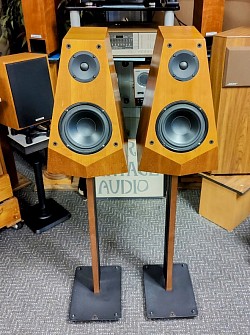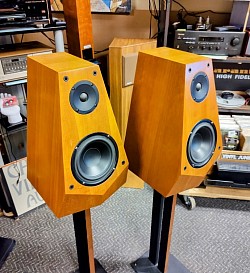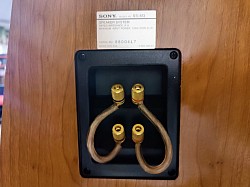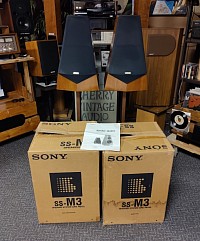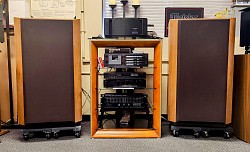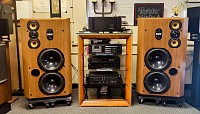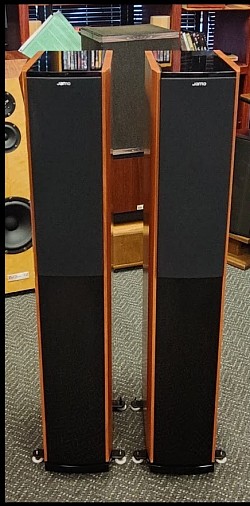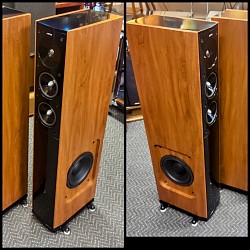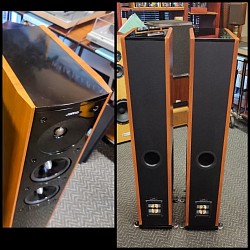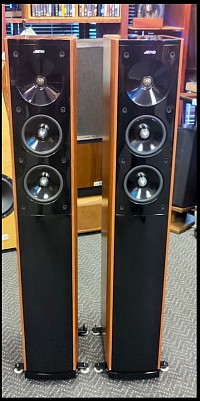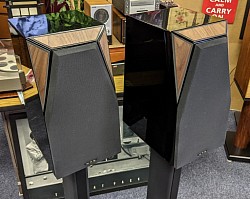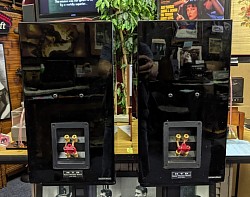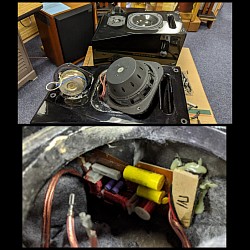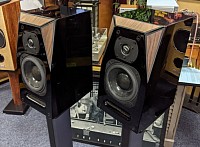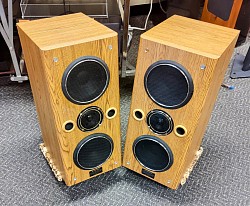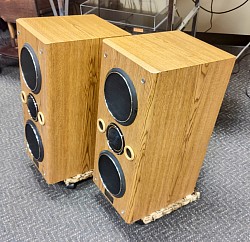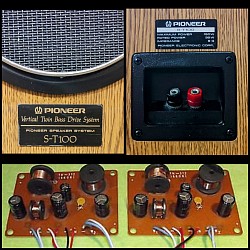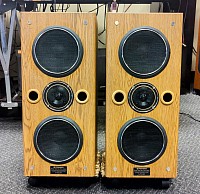Page 2 Stereo Speaker Systems
Sony SS-M3
('94-'97) $600 (rare, including stands)
In splendid cosmetic condition, these very special, very rare Sony MS-33 speakers produce a quality of sound that should be expected when Danish-made Peerless drivers are involved. This model was originally part of Sony's highly respected ES (Extremely High Standard) Series made in the USA. The SS-M3 is a bass-reflex design (sealed box.)
Included is a pair of 28" tall iron / wood stands (by Lovan), original manual and the original factory boxes with packing materials.
(NOTE: It's a somewhat normal assumption that Sony, being a huge "big box" retailer with a global supply chain of huge proportions, was incapable of designing "audiophile level" loudspeakers. When they introduced the SS-M3 and M9, it's generally agreed that they shattered that assumption.)
For its ES line, Sony gave ex-Polk engineer Dan Anagnos a clean slate to produce loudspeakers that could compete in the high end. The M3 was the smallest of the three models compared to the midsized M7 and the large M9 floor standing model .
Introduced to the public in the mid 90's, the Sony SS-M3 speakers are unusual for several reasons.
First, a key aspect of the M3's design is the cabinet. It needed to be narrow in the region of the tweeter bass unit in order to optimize treble dispersion, hence imaging. However, it also needed to be wide enough to accommodate a woofer capable of moving sufficient air to achieve good bass extension. The result is a narrow pyramid/trapezoid fabricated from thick MDF, veneered on all sides, and filled with polyester fiber—that is considerably deeper than it is wide.
Second, they are solidly built, bi-ampable, high-end drivers inside those gorgeous enclosures.
Third, not many speaker designs came out of Japan (yet built in the USA) for which there is somewhat 'universal' acclimation of good sound. The SS-Mx line from Sony is one exception. Most likely because they use high-end Peerless drivers sourced out of Denmark/Holland rather than their own make.
Finally, these have excellent grills made of black material stretched over angled frames to minimize any acoustic obstruction in the vicinity of the upper-frequency drive-units.
The 6.5" mid-bass drivers and 1" dome tweeters are Danish made Peerless, the same as those used in certain Snell models (and others). .
Design was not only to minimize internal resonances but also an attempt to do the same with edge defractions on the front baffle. The non-vertical front baffle is also to 'time-align' the tweeter and low range driver so that the highs and mids/low range reach your ear at the same time. There are a number of speakers that use this concept. As shown in the photos, the steep-slope crossovers are on their own printed circuit boards screwed to one of the cabinet sidewalls.
The original MRSP was about $900 when released which, today with inflation, would put them at about $1700.
Essential specs:
Power: 120 watts max
Frequency Response: -3dB 70 Hz
Finish: Cherrywood veneer
Impedance: 8 ohms
Connection: Gold plated wire ports / inserts -wireable, bi-ampable with jumpers.
Crossover: Steep-slope 24 dB-per-octave (reduced comb filtering)
Dimensions (semi-trapezoid design): 18.5" high, 12" wide (max), 12" deep (max)
Weight: 29 lbs each
About Sony...
There are few companies as storied as Sony of Japan. It was in 1946 that Mr. Masaru Ibuka and Mr. Akio Morita together with a small team of passionate and committed group of employees started to build “Tokyo Tsushin Kenkyujo” (Totsuko), or “Tokyo Telecommunications Research Institute” into the well-known global conglomerate that it is today. The main objective of the company was to design and create innovative products which would benefit the people.
The company name of Sony was created by combining two words of “sonus” and “sonny”. The word “sonus” in Latin represents words like sound and sonic. The other word “sonny” means little son. Used in combination, Sony is supposed to represent a very small group of young people who have the energy and passion towards unlimited creations and innovative ideas. With the far-sight of expanding worldwide, it was in 1958 that the company formally adopted “Sony Corporation” as its corporate name. Easy to pronounce and read in any language, the name Sony, which has a lively ring to it, fits comfortably with the spirit of freedom and open-mindedness.
At the beginning of 1959, Sony founder (and President at the time) Masaru Ibuka spoke about his New Year's dream for a transistor TV in a magazine interview. Japan's first transistor radio had gone on sale only four years earlier. The next target was a transistor TV.
Ibuka spoke of it as a dream, but in fact things were already taking shape behind the scenes. Steady progress had already been made toward realizing that dream. Transistors with enough display power to be useful for TVs were comparably more difficult to create than transistors for radios, but Sony had perfected these special transistors the year before, in 1958, and work on developing a transistor TV was already underway.
Development accelerated sharply from the beginning of 1959. The first prototype was completed in April and numerous improvements and design studies were carried out. On December 25, Ibuka's New Year's dream came true with the announcement of Sony's first TV---the world's first direct-view TV. When it went on sale in May 1960, the TV8-301 8-inch portable transistor TV launched Sony's TV business.
As it happened, a group of market researchers representing US TV manufacturers visited Japan when the transistor TV was under development. Ibuka asked them whether they thought small TVs would sell or not. To a man, they said they would fail.
Looking back on this later, Ibuka said that it was common practice in the US to plan new products on the basis of market research, but it was also possible to carry out market research for the first time by actually putting something on the market. Since then, he said, he believed new products always involved market creation, too. "I'm now firmly convinced that brand new products must always create new markets."
Two years later in 1962, the TV5-303---which was even smaller than the TV8-301---became a huge hit in the US.
The rest, as they say...is history.
++++++++++++++++++++++++++++++++++++++++++++++++
++++++++++++++++++++++++++++++++++++++++++++++++
Bowers & Wilkins Series 80 Model 808
('84-'89) $4700
Obtained from the estate of the original owner, this amazing pair of B&W Series 80 / 808 speakers are completely original and in perfect operating condition. Even the enormous, heavy grills are original and in excellent condition.
The 808 is a 3-way speaker system utilizing 5 drivers: two 10.5" woofers for the bass, two 4" midrange speakers and a single .05" dome tweeter for the treble, mounted in a bass reflex enclosure. The gold plated, tri-wire speaker banana jacks have the original factory jumpers installed for demo purposes.
NOTE: Most of the information regarding these speakers is readily available online. We have borrowed some of that info as presented here.
The midrange drivers are manufactured from Kevlar, the same material used for bulletproof vests. Because the material is virtually indestructible, it`s incredibly expensive to form. The advantage is that once formed it never deteriorates or changes shape, vibrates uniformly and it endures an enormous amount of movement without damage. The highly efficient crossover network that sends the proper frequencies to the proper drivers, also compensates for time and phase, so all the sound reaches your ears simultaneously.
Product Summary
In some specialized music contexts, reproduction to reference standards is often required at very high sound levels indeed. This requirement presented yet another challenge to our design team and it is the raison d’etre of Model 808, which completes the trio of B&W master monitors.
Five completely new drive units are built into the three-way system with double the sensitivity of conventional professional monitors and overall frequency linearity free from coloration and distortion.
Tech highlights:
The TX32 tweeter achieves wide dispersion and extended frequency response. Yet it is capable of high sensitivity and well able to withstand the high currents involved. The Ferrofluid between the coil and pole piece cools the critical voice coil.
The problems posed by the necessary large enclosure of the 808 are met by the closed box system of utmost rigidity. To defeat coupling with the larger bass enclosure, a quarter-wave transmission line rear-loading system is incorporated.
Two 11" bass drive units operating within an enclosure of 220 litres fulfill both the bass extension and sound pressure level requirements. To achieve 91dB efficiency in the bass extension computer predictions indicate a fourth order alignment vented system and 808’s drivers are optimized around this design.
Back story (info from the Audio Base website):
The development of the 808 began in October 1981 when President Nimro Nakamichi asked B & W President John Bowers to co-develop it. After that, based on the specifications presented by Nakamichi, two engineers conducted repeated technical negotiations and Mr. Bowers conducted hearing coordination in the trial listening room. The development took three years.In the specifications presented by Nakamichi, there were 3 specific things written.
First, the flat frequency characteristics should be used to eliminate the colorization in the same way as in 801F to achieve an ultra-low distortion rate. Second, the efficiency should be twice that of 801F to obtain 91 db at 1W input power. Finally, the maximum sound pressure obtained in the listening room should be on the order of 120 db (125 db at peak).
The background to these requirements was the judgment that the monitoring capability of digital recording would become an essential requirement for pro-monitor speakers in the future, and that it would be necessary to support not only classical music but also all music sources.
To achieve these specifications, the B & W project team began with the design and manufacture of driver units with low distortion even at high sound pressure levels. The Nakamichi advice on total integration. The results are reflected in the Quarter-wave Transmission Line system for medium-to-high-range enclosures, the shape of the enclosure, and sound creation. In addition, B & W's expertise is fully utilized, including vibration analysis using a laser interferometer and the adoption of a computer-based crossover network using numerical optimization technology information.
It is interesting to note that Abbey Road studio in England was one of the first studios to install and use the model 808. That fact alone contributed to the legend of these incredible speakers.
Specs:
Type: 3 way, 5 driver loudspeaker system
Frequency Response: 30Hz to 20kHz
Impedance: 8 ohms
Sensitivity: 91dB
Bass: 2 x 11.8"
Midrange: 2 x 4"
Tweeter: 1 x proprietary TX32
Enclosure volume: 7.8 cubic feet
Finish: walnut
Dimensions: 25"W x 21"D x 42"H
Weight: 180 lbs each
About Bowers & Wilkins...
The sleepy coastal town of Worthing in South England might not look like a hotbed of 1960s freewheeling experimentation, but for audio fans it’s a place that’s synonymous with innovation.
Thanks to the first Bowers & Wilkins speakers built there in the early years of the company, music lovers could experience albums such as Sgt. Pepper and Pet Sounds in new, mind-expanding depth and clarity.In 1966, John Bowers set up his company with his partner Roy Wilkins and began assembling speaker systems in the workshop of their electronics shop and designed their first speaker, the P1. The profits from this beginning allowed them to invest in new calibration equipment.
By 1968, the high quality "Domestic Monitors" (DM1, DM3) brought more recognition from the audiophile community.In the 70's, with John Bowers at the head of the company, things really took off...with the development of curved cabinet forms and the use of new cone materials such as Kevlar, they hit it big with the Model 801 which almost immediately became the reference speaker of choice for many of the world's leading recording studios.
Also, the first model DM6 from acclaimed designer Sir Kenneth-Grange appeared in 1976. The later DM7 was the first that featured the iconic "tweeter-on-top" that's still used today.In the 90's the appearance of the (now very famous) B&W "Nautilus" which totally upended the preconceived notions of speaker design.Even though John Bowers passed away in 1987, today, in the so-called digital age, B&W just keeps moving along with its latest versions of the Diamond Series and so much more.
+++++++++++++++++++++++++++++++++++++++++
+++++++++++++++++++++++++++++++++++++++++
Jamo S-606
(2008) $600
In spectacular cosmetic condition and (of course) fully operational, this stunning pair of Jamo S-606 were first introduced in 2008. They were thoughtfully designed using luxurious "dark apple" (aka cherrywood) laminate for the sidewalls and narrow strips running the length of the front of the baffles. The rest of the enclosures feature piano black gloss laminate for the tops and front baffles. Removing the grill reveals the inline drivers with the mids featuring silver metallic phase plugs.
The S-606 was originally part of a surround system that was dangerously close (yet substantially better) than some of Jamo's well known and respected, so-called "budget" models. Obviously (to us), these S-606 towers were definitely the heart of that system. As a standalone set, this pair of S-606 is a very high quality speaker system with each enclosure weighing in at about 53 lbs each.
Our in-store "shootout" with the Jamo S-606 against a pair of more expensive Sonus Faber Venere 2.5. Hands down, the Jamo sounded better to us using the same amp and same demo tunes.
So...in our humble opinion, the S-606 sounds even better than they look.
The S-606 is a 3-way bass-reflex design (ports on the rear) with five-way gold plated binding posts and jumpers.
Each 42" tall cabinet features a single soft dome 1" tweeter (with textile base) and two 5" MF/LF (midrange) drivers (fitted with heat dissipating metallic phase plugs instead of dust caps.)
The tweeter and mids are placed into a separate sealed compartment that improves isolation with the woofer. The 8" woofers are placed on side walls of the lower part of the enclosures.
Reviewed everywhere, the consistent comments were "the Jamo S-6060 are focused, dynamical, open, accurate, and neutral by tonal balance".
We might add that, like every high quality speaker system, it's best to drive them with good quality amp power to bring out the best they have to offer.
Specs:
System type: 3-way
Enclosure type: Bass-reflex
Frequency response: ± 3dB42 - 20000 Hz
Nominal impedance: 6 Ohm
Amplifier Requirements: 15 - 210 watts
Sensitivity: (2.83V/1m)89 dB
Dimensions: 42"H x 7.5"W x 13.5"D
Weight: 53 lbs. each
About Jamo...
Jamo is a Danish manufacturer of loudspeakers. The company was founded in 1968 by Preben Jacobsen and his brother-in-law, Julius Mortensen. The company name is derived from the founders' surnames. At one point, Jamo employed more than 400 workers at its factory in Glyngore and grossed hundreds of millions of dollars; in 1994, it was Europe's largest speaker manufacturer.
In 1998, the company had produced and sold more than 11.5 million units. In 2002, businessman Anders Hoiris was hired as director to reverse declining sales. His efforts proved unsuccessful; a major company backer, FSN Capital, then transferred its interest in the brand to Jystke Bank. Hoiris then resigned. Company production has, since 2004, been located in China. Jamo was taken over in 2005 by the well known American firm Klipsch Audio Technologies which Hoiris had arranged for before his departure.
+++++++++++++++++++++++++++++++++++++++++++
+++++++++++++++++++++++++++++++++++++++++++
HTD Level Four
(Early 2000's) $500 (extremely rare)
These very rare HTD Level 4 speakers were built using only expensive, high-tech components featuring gorgeous carved enclosures with a stunning, authentic piano black laminate finish and real mahogany. Essentially, the Level Four speakers are a high level audiophile speaker system that's as exciting to listen to as it is to look at.
Only around for a few years, the HTD Level 4 speakers were incredibly difficult to design and produce in a cost effective manner. The time consuming production *process resulted in a limited run mostly due to cost vs ROI. They simply could not justify continuing to sell them at their original price point of $400/pair. It was either substantially raise the price or discontinue the model. So...they decided to halt production. The Level 4 are almost completely under the radar today. They are a collector's dream...
This modest sized speaker produces a big, warm and smooth sound that is both musical and powerful. For use primarily as a bookshelf speaker that needs to be placed on heavy duty stands.
The Level FOUR includes the following features:
~6.5" drivers with doped pulp cones, butyl rubber surrounds, cast aluminum baskets, 2.5" voice coils, and high-efficiency neodymium magnets
~silky smooth 1.1" ferrofluid cooled silk dome tweeters
~3rd order crossovers on both the tweeters and mid-range drivers
~Dual bi-wireable gold-plated 5-way binding posts
~Removable shaped wood and cloth grills
~Knife-edge fit and finish cabinets made of CNC carved 1" MDF with internal bracing
~Internal tuned channels that end in front firing, elliptical ports for enhanced bass
~Video shielded for safe placement near a TV
*True Piano Finish-
Most medium-grade and even some high end speaker brands use an inexpensive vinyl covering called "simulated" piano finish (although the word simulated is often omitted). This plastic material is shiny but it looks nothing like the true, rich high gloss finish that HTD creates. Others simply use a glossy paint and call it "piano finish". We use a multi-step process of applying lacquer, drying, sanding and cleaning. This process was repeated a minimum of seven times and took about fourteen days per speaker cabinet! The result was obvious in the stunning, deeply rich finish of every Level FOUR model.
Specs:
Power Handling: 110 watts RMS, 150 watts max
Frequency Response: 45 Hz - 20 kHz +/-3dB
Impedance: 8 ohms
Sensitivity: 88dB
Woofer Driver: 6.5" doped pulp with butyl rubber surround, cast basket, 2.5" voice coil, 4 OZ neodymium magnet
Tweeter Driver: 1.1" silk dome, 5 + 3 OZ ferrite magnet
Crossover: 3rd order on both tweeter and woofer at 2500Hz
Dimensions (HxWxD) 16" x 8 3/4" x 11 1/2" (bottom) 10" (top)
Weight (each): 27 lbs
About HTD...
HTD spun out of a company that began designing and manufacturing high quality audio equipment for many of the biggest brands in home audio in the early 1970's. They leveraged their expertise in designing and producing quality audio gear for others into the creation of their own HTD brand in 1998. The first HTD speakers were sold direct to consumers in January 1999 and Home Theater Direct, Inc. became its own company in early 2001. With the advent of the internet, their decision to sell only direct to consumers was easy. Selling direct saved the customers' money by eliminating the price increases tacked on by distributors and retailers, as well as by catalogers and other internet stores. HTD (Home Theater Direct) is a different kind of home audio company. They only sell what they make, and their HTD brand is only sold directly to consumers.
++++++++++++++++++++++++++++++++++++
++++++++++++++++++++++++++++++++++++
Epi Microtower-1 (MP1)
aka "Epicure Model 75" ('73-'74) $200 (rare)
This hard-to-find pair of vintage omni-directional Epicure MT-1 Microtower speakers feature two 4.5" full range drivers in each enclosure.
They have an encompassing, full soundstage between them producing a warm, non-fatigue experience. They are perfect for any small to mid-sized room. Rated at 5-50 watts, they are very efficient as well.
Originally designed in the mid-1970s, there were three different models, MT1, MT2 and MT3. There was a fourth model called the MTB2 that shared parts with the others but not much more. All were tall, thin columns with bottom vents, intended to be relatively omnidirectional.
Placement: The sides with the "Epi" logo would face forward, the drivers then spread the sound outward and away from the listener yet manage to fill the room with little effort. Placed correctly, they do put out an omnidirectional sound, as intended. Some were marked EPI and some Epicure.
Relatively rare, we think they are a welcome addition to any vintage collection. Of course, they are a very cool design featuring glass tops and the circular Epi logo screens are similar to passive radiators although they don't really affect the sound much. This pair was made with a walnut vinyl finish. All of the Epi badges and grill covers are complete and in good condition. Overall, these are in good shape considering their age.
About Epicure (Epi)...
EPI was founded in 1970 by Winslow Burhoe, to manufacture speakers based on the "module" he had designed. This module consisted of an eight inch woofer and a one inch tweeter. Many different speakers were built using various combinations of this module, and a six inch version of the woofer. They were wonderful speakers and are still usually prized by their owners, who will frequently go to great lengths to repair them properly when they (rarely) develop problems.
+++++++++++++++++++++++++++++++++++++
+++++++++++++++++++++++++++++++++++++
Pioneer S-T100
('88-'90) $300
This pair of Pioneer S-T100 speakers are in exceptional cosmetic condition and fully operational. They are best described as a bit of a conundrum. At one time, Pioneer designed some incredible speaker systems (like the legendary HPM Series, S-1010, and a few others). But then, like other Japanese "big names", they also pumped out a lot of "just ok" models. During the late 80's Pioneer produced the S-T100 and, to some, it was a shock because they sound really dang great!
Priced at $600/pair and packaged in heavy oak cabinets, Pioneer described these as their "vertical twin bass drive system" design. Apparently, Pioneer decided that "it's all about the bass" with the S-T100 because they can go deep. For those that prefer to taper that deep bass, the ports can be "tuned down" with the included foam inserts.
Thanks to an intelligent crossover design, the mids and highs are also excellent. Overall, the Pioneer S-T100 is a remarkably great "under-the-radar" speaker system.
Each oak veneer enclosure has all the original drivers including two 6.5" mid-bass units (with enormous magnets) and a single high quality 1" cone tweeter. There are twin front-firing 1.5" bass ports placed horizontally, mid center on either side. On the rear are standard banana connections.
The highly customized enclosures were created out of necessity because the grills were toast. For grills, all the mid-bass drivers have custom 6.25" chrome rings with black fiberglass screen material. The tweeters have chrome rings attached to curved, black metal protective screens. The bass ports have 2" round wood attachments. The overall effect exposes all the beautiful oak on the front baffles instead of hiding it behind typically ugly black grill cloth. The enclosures were finished off with curved (radius) edges up front.
Comments from owners on AudioKarma:
"Pioneer S-T100. Bad ass...think they are the Boss and sound like they are. Early 90’s and incredible..."
"I've had the Pioneer S-T100's and after listening to them against many other loudspeakers in a fairly high end audio store, I thought they beat the competition quite handily..."
Specs:
Impedance: 6 ohms
Frequency range: 35 to 40k hz
Sensitivity: 91 dB
Max power: 150 watts
Dimensions: 23"H x 13.5"D x 10"W
Weight: 32 lbs each
About Pioneer speakers...
Pioneer electronics started in japan by Mr.Nozomu Matsumoto in 1937. He was a very passionate individual who loved music and loved technology. He took it upon himself to create a loudspeaker built in japan that would reproduce the same quality and performance of the products that he was buying from overseas. Nozomu Matsumoto’s first business was a radio repair shop where he was fixed and repaired products made by others. In the same shop, he began creating Pioneer Speakers.
Mr.Nozomu Matsumoto built these speakers because he wanted to share with people the same strong passion and excitement he experienced while listening to imported speakers. "Pioneers’ original mission was to share the listening experience with more people." – Mr.Naoto Takashima (Director, Tohoku Pioneer)
"Pioneers strength is the ability to deliver our founder’s philosophy to practically any listener at all price points. By applying technology and experience developed for TAD and other high-end pioneer speakers, even our least expensive speakers achieve our mission". – Mr.Naoto Takashima (Director, Tohoku Pioneer).
+++++++++++++++++++++++++++++++++++++++++++++++
+++++++++++++++++++++++++++++++++++++++++++++++
Marantz HD88
('76-'81) SOLD (one owner, pristine)
This beautiful (and rare) pair of Marantz HD-88 was obtained from the original owner who just happens to be a retired Marantz technician that worked for many years at the company's production facility in Chatsworth CA.
Fully serviced, checked, restored and tested, they are in excellent cosmetic and working condition.
The woofers have been professionally reformed and all the crossover film caps are still within their correct values. All mids, tweeters and super tweeters are functioning perfectly. The original "Vari-Q" port plugs have been restored and function as intended. The "L-pads" (tone controls) have been pulled for deoxit treatment and function as intended.
Unfortunately, the original foam grills have long since deteriorated (as they almost all did for this series over the years.) They have been replaced with new wood frames and acoustically transparent black fiberglass grill material. This unique material allows a subtle view of the drivers and especially the attractive aluminum trim rings. The baffles were coated and sealed as well.
Back story:
The Marantz HD-series (HD77 and HD88) were made from '77 to the early '80s.
NOTE: The highly respected loudspeaker designer, Ed May had his hand in the Marantz HD series. *See below for the bio of Ed May.
At the time, Marantz was still Marantz and not something else. Or rather, it was Marantz Superscope whose products were manufactured by the Japanese Standard Radio Corp. Later, the company changed its name to Marantz Japanese.
The HD88 measures 42" high x 15" deep x 12" wide. It’s a 4-way speaker with two 1" textile-dome super-tweeters, one 4" dome tweeter, a single 4.75" midrange driver and one ported 12" woofer. The crossover frequencies are 500 Hz / 3 kHz / 8 kHz.
The bass response can be adjusted by inserting the "Vari-Q" foam plugs into the port, the technique that was kind of invented in the early '70s. The HD88 was the last Marantz speaker to use the thick foam grill. Unfortunately (like almost all of them) they deteriorated over the years and were replaced with a textile grill. Fortunately the HD88 is quite a handsome speaker even without the grill.
Marantz, aka SRC in Japan, aka Superscope, employed small tricks to execute ‘high definition’: polyester hemispherical membranes and a "Vari-Q" acoustic plug permitting tilting the response between acoustic suspension and bass-reflex.
The power handling score and the frequency response plus at -3 dB are impressive. The 0.05% distortion is down to 35 Hz – also impressive! One thing is for sure… with the 90 dB efficiency rating and up to 300 watts input, you can make them rock!
The bonus is that they are beautiful speakers, and after all...they are Marantz! That aids a bit to the impact when you have them connected to a solid Marantz receiver or amp
Specs:
Type: 4 way, 5 driver loudspeaker system
Frequency Response: 25Hz to 25kHz
Power Handling: 300W
Crossover Frequency: 500, 3000, 8000Hz
Impedance: 8 ohms
Sensitivity: 90dB
*Bio of Ed May: https://www.audioheritage.org/html/people/may.htm
Marantz; a different perspective...
More than any other person, Saul Marantz defined premium home entertainment. Driven by his passion for music and his accomplishments as a classical guitarist – accomplishments that led to a close friendship with Andres Segovia – he was never satisfied with the “hi fi” equipment of his day. So he built better; first in his basement, later in a factory. His talent for industrial design and his ability to infuse talented engineers like Sidney Smith and others with his vision resulted in legendary products: The Model 7 preamplifier. The Model 8 and, soon after, the 8B power amplifier. And insured that his company would remain a premiere name in the industry he helped establish.
In the 1960’s Marantz made multiple significant moves. NASA found the Model 9 stable enough to be used in tracking stations around the world as part of the famous Apollo space program. Marantz also decided to relocate to California within this decade. Most notably, in 1964, Marantz was acquired by Superscope.
Fueled by financial backing, innovative product development and additional production facilities in Japan, Marantz experienced excessive growth and expansion in the 1970’s. It was also the decade of the famous “2200” receiver, which turned out to become the most successful receiver line in consumer electronics history.
To Marantz, perfect specifications and technical accomplishment count for nothing unless a product can unlock the power, the excitement, and the emotion of music. Their heritage of technical excellence means they can create components with the ability to communicate the scale, timbre, pitch, and dynamics—in fact, the very essence—of a recording. Every Marantz component is technically and cosmetically designed to complement the lifestyle of the listener.
++++++++++++++++++++++++++++++++++++++++++
++++++++++++++++++++++++++++++++++++++++++
